Features and applications of epoxy floor paints
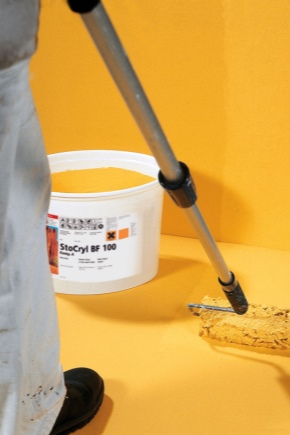
The use of epoxy floor paints has a number of important features. It is imperative to take into account the specifics of the chemical composition and the procedure for using enamel for concrete. An accurate knowledge of the types of concrete floor paint allows you to succeed even in rather difficult situations.
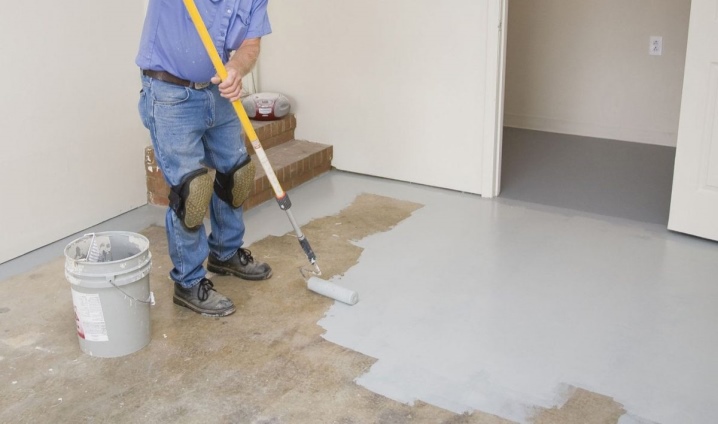
Description and purpose
Concrete floors are distinguished by their reliability and mechanical strength. Because of these factors, they have gained widespread popularity in industrial and residential construction. They are also used in social and cultural facilities, in auxiliary buildings, and so on. But with all the advantages, a very important drawback is characteristic of a concrete floor - it is not very attractive in appearance. Yes, it can be a kind of aesthetics, but the abundance of such views in a room becomes boring over time.
And it's not just about external properties, by the way. Concrete without special treatment is characterized by a strong porosity of the structure. It will be subject to intense erosion, and the destroyed surface of the material will become an invariable source of dust.
Even a simple dry cleaning is enough for a thin layer of powder to appear on the surface.
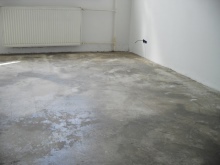
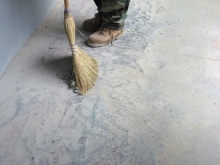

There are, of course, special concrete placement and handling techniques to reduce dusting. However, it would be most correct to solve the problem systemically, by eliminating its source in the bud. In addition, an uncovered concrete surface is easily damaged by contact with moisture, with various aggressive substances. The use of tiles, laminate, tiles, linoleum and other materials is often impossible, difficult or economically impractical. It is much easier to apply epoxy floor paint in many cases. It is a special blend of two water-based ingredients.
You will have to dilute such enamel just before application. The proportions are selected individually. When the coloring composition sets, it forms a strong film. The screed underneath is effectively protected from external influences.
Masking of minor superficial violations is guaranteed; it is also important to increase the overall decorativeness of the composition.
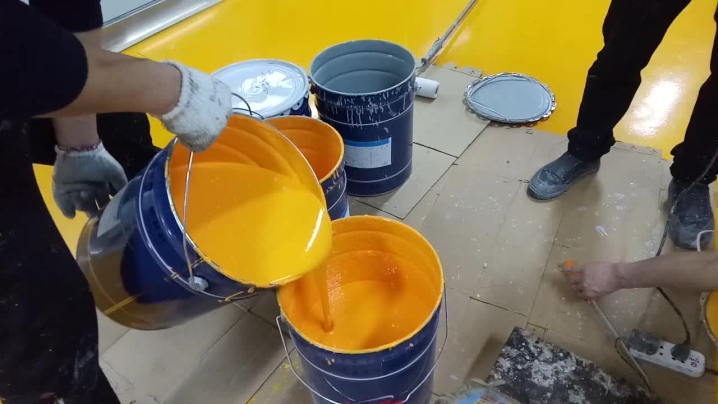
The epoxy is resistant to almost any external influences. That is why it can be safely used in the gym, in the warehouse, and at the production site. The high hygienic properties of such paints make them optimal for medical, veterinary, children's institutions, laboratories and highly clean industries. The resistance of epoxy paints to moisture makes them suitable for wet rooms or open air concrete. Also worth noting:
low susceptibility to reagents used in laboratories, auto repair organizations, main industries;
no organic solvents in the composition (i.e. zero volatility);
lack of bad odors during the painting process;
zero toxicity level;
suitability for application on concrete as early as 120 hours after the formation of the screed;
decent adhesion to a concrete base;
increasing the strength of the substrate;
closing the pores of the most unstable floor layer.
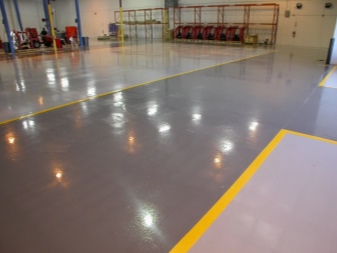
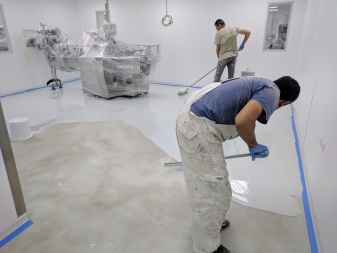
Attractive appearance is another undoubted advantage of epoxy paint. Some people form a structured embossed surface, others prefer a glossy color. With the help of special additives (so-called chips), slight irregularities in the base can be masked and decorative properties can be increased. It is worth considering that modern epoxy paints (unlike those used in the past) can be presented in many shades according to the RAL scale, and not only in gray.
The original tone will be retained for a long time. It does not degrade even when exposed to ultraviolet light. It is easy to clean epoxy-coated floors, and it lends itself to regular dry cleaning. It is worth considering the disadvantages of such paints: you have to work with them energetically and quickly, otherwise the composition loses its applicability.
In addition, the individual components of epoxy paints can be toxic and adversely affect the environment.
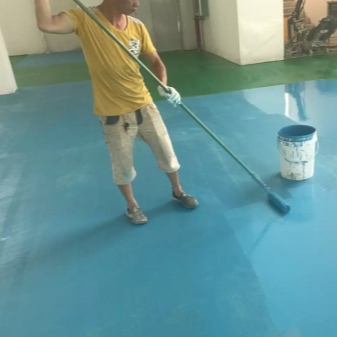
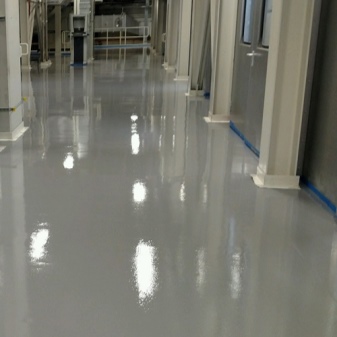
Instructions for use
Surface preparation
Epoxy mixtures can be applied to both newly poured screed and already used concrete. Depending on this, one or another preparation option is chosen. A fresh concrete surface is painted when it sets and will allow movement without any risk. It is also necessary to evaluate the moisture content of the base - water-soluble epoxy mixtures are well applied only to surfaces with a certain level of moisture. The quality of the screed itself is of great importance - any cracks, grooves and other deviations that require repair work are unacceptable.
The first step is to remove the upper part of the "cement milk", during this procedure, the concrete pores are opened. Experts advise using the grouting machine known in professional circles as the "helicopter". If it cannot be applied, use a stiff brush. The more doubt a particular place inspires, the more attention it needs to be paid. Having coped with small debris and vacuuming the surface, you can already start painting.
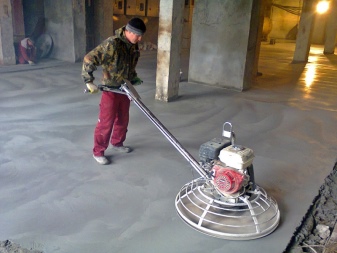

If the screed is laid long enough (as the pros say - "ripe"), then the approach changes dramatically. In this case, a very wet solution will penetrate into the coating much worse. Adhesion is also broken when using it. Normally, the surface moisture content of coatings cannot exceed 4%. Violation of this norm leads to gradual flaking of the epoxy coating.
It is not necessary to buy specialized devices for determining surface moisture. You can solve this problem using the means at hand. A 40x50 cm strip of polyethylene is glued along the perimeter with adhesive tape.If after a day sweat appears on top of it or when you touch it, you feel obvious moisture, it means that you cannot paint yet.
It is necessary to additionally dry the floor.
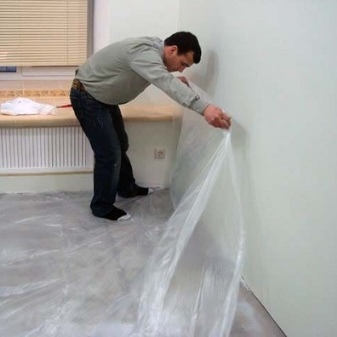

Next, you need to check all possible weaknesses and blockages. Be sure to clean up:
flaking areas;
coloring zones;
oily and other pollution.
Large cracks, slits are cut at least 0.5 cm wide. When this is done, a thorough cleaning of the surface must be carried out. It includes both cleaning from coarse dirt and processing with a powerful vacuum cleaner. Places that need to be repaired are initially marked with a marker or any other convenient method. To close defects, epoxy putties of a special series are used, and strictly after using the initial primer coat of paint, until it grabs and closes the pores.
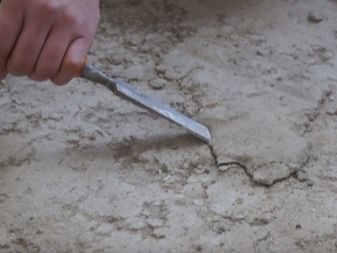
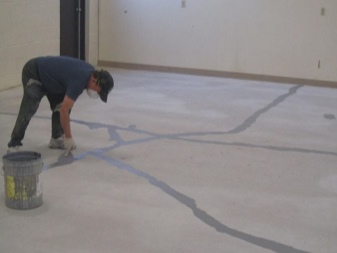
Primer application and painting
It is possible to treat concrete with soil and paint it at temperatures from 5 degrees. The air should be warmed up from 5 to 25 degrees with a relative humidity of no more than 80%. The temperature of the finishing materials used is normally 15-25 degrees. Epoxy painting is practiced only for concrete grade M200 and higher. To work properly, you have to prepare:
a drill with a stirring attachment (ideally a construction mixer);
a set of spatulas;
paint rollers;
paint brushes;
individual protection means.
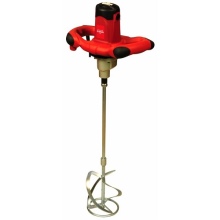
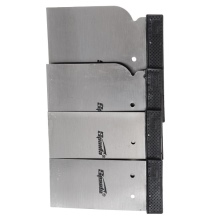

Despite the absence of foreign odors and toxic properties, it is imperative to work with fresh epoxy mixtures in a respirator. When the individual components of the paint or the prepared mixture get on the skin, mucous membranes, it is necessary to wipe the affected area with a soft cloth, wash it with a large volume of running soapy water. Wearing the following helps to minimize the risk:
gloves;
work gowns or suits made of cotton fabric;
shoes with leather soles.
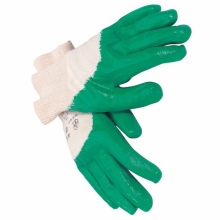
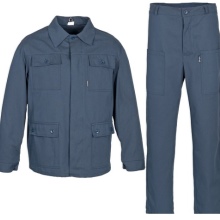
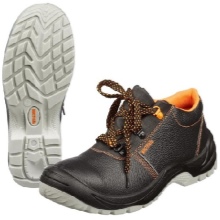
Substances recommended by the paint manufacturer are usually used for priming. If there are no official recommendations, you can take the paint itself as a primer diluted with pure water by 10-20%. In any case, the scheme of work is approximately the same. Substance "A" is thoroughly stirred in a standard tank until complete homogeneity is achieved, but for at least 2 minutes. Continuing stirring, gradually add the desired volume of component "B".
When it is added, you must continue stirring for at least 3 minutes. Experts advise to vary the direction of twisting (in one direction, in the other and vice versa). Stir the "dead" areas very carefully - the corners of the bottom and walls. It is necessary to prepare the primer by adding clean water at the same stage. Its temperature should be the same as that of the main composition.
The fully mixed mixture is left alone for 3-5 minutes. This is enough for all air bubbles to come out. Preparation of the composition is carried out with the expectation of full production in ½ hour. Experienced builders believe that it is necessary to quickly pour the prepared paint or soil in the form of a "snake", and only then distribute it. This will save a lot of valuable time - the average consumption of primer is from 160 to 240 ml per 1 m², and more is used only in places with increased absorption.
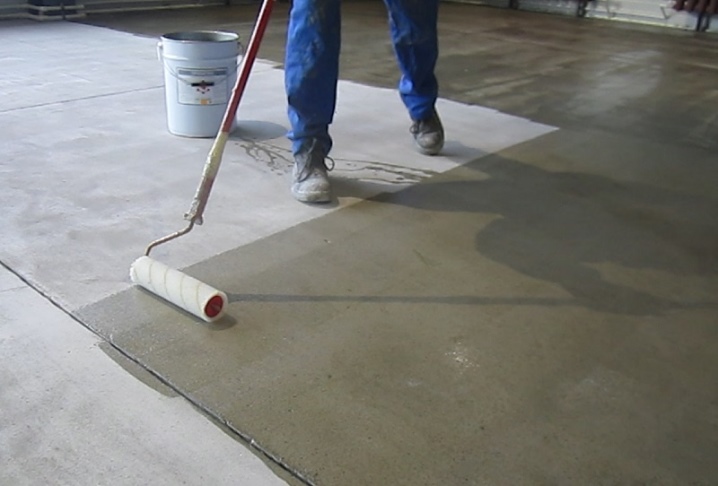
The end result is the formation of a uniformly colored surface with a slight matte sheen.
Further, as necessary, repair work is carried out. At this moment, the previously cleaned and cut areas are filled with an epoxy-based concrete putty. It is compacted and leveled with a spatula. Applying a primer over the patches is at the discretion of the repairmen.
The first coat of paint is applied exactly 24 hours after priming. First, the corners and other inaccessible areas are painted with a brush. The main surface of the floor is painted with a roller. The average consumption of epoxy paint will be 300 ml per 1 m².
Longitudinal and transverse movements of rollers, brushes are better to alternate.

Species overview
Epoxy paints for concrete are classified according to the method of curing (cold or hot). The difference between them concerns both operating temperatures and the type of hardener used. Professionals use hot mixes. However, for personal use, "cold" compositions are much more practical.
According to the form of paint release, they are divided:
on two-component;
aerosol;
water-dispersive;
powder.
For concrete, two-component compositions are best suited (therefore, they were discussed above). Sometimes they use mixtures diluted with water. If silica dust is used, the paint will have increased wear resistance. UV protection is enhanced by the introduction of acrylic resin.
And if the manufacturer adds phenolic resins, the susceptibility to aggressive substances will decrease.
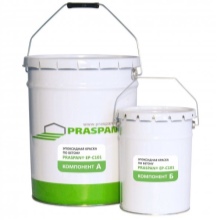
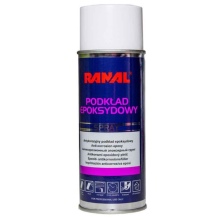
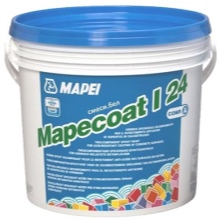
Popular brands
It enjoys a very wide demand Finnish Tikkurila products... Its paints are appreciated for their excellent performance properties. The two-component composition shows itself equally well on both new and old screeds, it can be tinted in any tone listed in the RAL catalog. But you can take a closer look at the products of other companies.
Epoxy paint "Epoxy" can give a good result:
average consumption - 0.25 kg per 1 m²;
drying - 24 hours;
pot life - 4 hours.
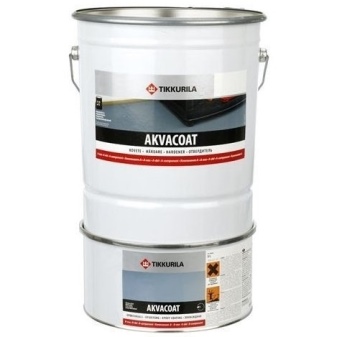
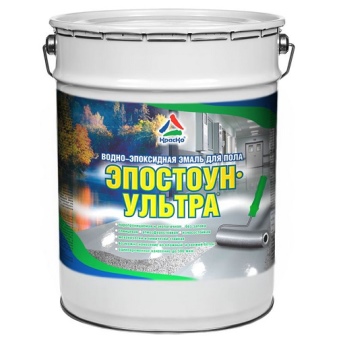
"Elakor-ED" better suited for outdoor work. The Russian company supplies 4 types of paints with enhanced protective properties.Thanks to special additives, the strength of the substrate increases by 80%. The minimum coating thickness is 2 mm. It always looks brilliant.
Epoxipol:
varies in composition (1 or 2 components);
has a drying time of 2/3 hours;
provides an average consumption of 0.2 kg per 1 m².

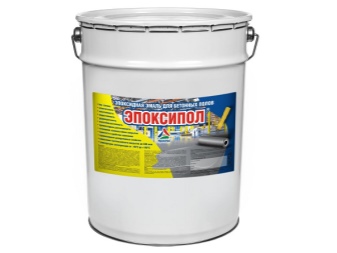
You can learn how to paint a garage floor with epoxy paint with your own hands from the video below.













The comment was sent successfully.